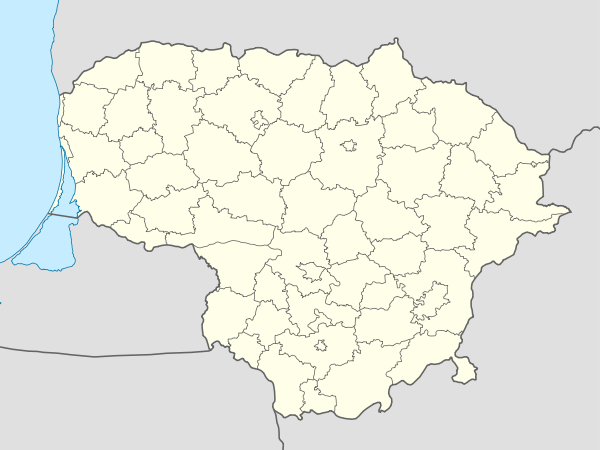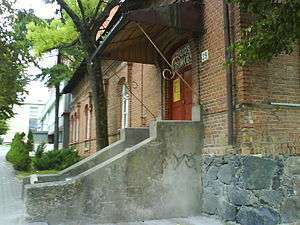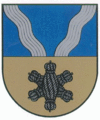Kupiškis
| Kupiškis | ||
|---|---|---|
| City | ||
|
City view from northwest | ||
| ||
 Kupiškis Location of Kupiškis | ||
| Coordinates: 55°50′0″N 24°58′0″E / 55.83333°N 24.96667°ECoordinates: 55°50′0″N 24°58′0″E / 55.83333°N 24.96667°E | ||
| Country |
| |
| County |
| |
| Municipality | Kupiškis district municipality | |
| Eldership | Kupiškis eldership | |
| Capital of |
Kupiškis district municipality Kupiškis eldership | |
| First mentioned | 1460 | |
| Granted city rights | 1791 | |
| Population (2012) | ||
| • Total | 7,892 | |
| Time zone | EET (UTC+2) | |
| • Summer (DST) | EEST (UTC+3) | |
Kupiškis (![]() pronunciation ) is a city in northeastern Lithuania. It is the capital of the Kupiškis district municipality. Kupiškis is located on the Lėvuo and Kupa rivers. The name of the city comes from the Kupa River. The Gediminas Bridge crosses the Kupa River. There are six parts of the city, which are named:
pronunciation ) is a city in northeastern Lithuania. It is the capital of the Kupiškis district municipality. Kupiškis is located on the Lėvuo and Kupa rivers. The name of the city comes from the Kupa River. The Gediminas Bridge crosses the Kupa River. There are six parts of the city, which are named:
- Centras (Center or Old Town; the oldest buildings in the city, town hall, sanitation and utility buildings, library, church, high school, blocks of flats, detached houses)
- Krantinė (high-rise housing complex between 4 and 5 floors, detached houses, shopping malls, preschool, primary school)
- Kraštiečiai (high-rise housing complex between 2 and 6 floors, shopping malls, preschool)
- Račiupėnai (a residential area; detached houses, middle school, business and technological school, bus station)
- Zuntė (a residential area; detached houses)
- Pramoninė teritorija (Industrial district; factories, warehouses, train station)

History
Archeological finds provide evidence that even in the 3rd and 2nd centuries BC people dwelt in the surroundings of Kupiškis. However, there is no information on when the very settlement was founded. The findings around the Aukštupėnai mound show that in the 8th century a wooden defence castle stood there.
Kupiškis was mentioned in historical sources for the first time in 1529. It was a property of Sigismund I the Old, the ruler of the Grand Duchy of Lithuania. From 1561 to 1565 it was a center of small ruler's center, belonging to the Upytė district and later the Ukmergė district. At that time the main road from Vilnius to Riga led via Kupiškis.
In 1616, the first Catholic church was built in Kupiškis. In 1781, the first school of the Lankasteriai family was established. The railway line from Daugavpils to Šiauliai to Liepāja was built in 1873.
Population
According to the Department of Statistics of Lithuania, the population of Kupiškis as of January 1, 2005 was 8,243. The ethnic composition of the Kupiškis district municipality, according to the 2001 census, was:
- 23,965 (97.3%) Lithuanians
- 430 (1.7%) Russians
- 64 (0.3%) Poles
- 49 (0.2%) Ukrainians
- 38 (0.2%) Belarusians
- 82 (0.3%) Other nationalities
Jews in Kupiškis
Kupiškis, known in Yiddish as Kupishok or Kupisik, was home to 1,444 Jews before World War II. In the summer of 1941, all of the Jewish men, women, and children in the town were herded into a makeshift ghetto and then marched to a cemetery reserved for atheists, where they were shot and buried in unmarked pits. In the aftermath of the war, Christian midwives compiled a list of more than 800 names of the murdered Jews. However, historians estimate that 1,500 to 2,000 Jews were killed by the Lithuanians "Kupiškis self-defense unit".[1]
The Great Synagogue in Kupiškis was built of stone. The red brick portion was a Misnagdim Synagogue. The Great Synagogue was used as the "Culture House" during the Soviet period. The Misnagdim portion is now used as a boiler room for heating the main building which now contains the Public Library and Wall of Memory Holocaust Memorial erected on July 13, 2004.
Educational institutions
Schools

- Kupiškis Laurynas Stuoka-Gucevičius High School (for students from 14 to 18)
- Kupiškis Povilas Matulionis Middle School (for students from 6 to 14)
- Kupiškis Kupa Primary School (for students from 6 to 10)
- Kupiškis Technological And Business School (for students from 16 to 21)
Art schools
- Kupiškis Arts School
Preschools
- Varpelis
- Obelėlė
- Saulutė
International relations
Kupiškis is twinned with:
Notable people
- Laurynas Gucevičius, a Polish-Lithuanian architect, was born in the village of Migonys near Kupiškis.
References
- ↑ http://www.holocaustatlas.lt/EN/#a_atlas/search/vcntfr=1000.vcntto=5000/page/2/item/204/
- ↑ "Oficiálne stránky mesta Kežmarok". kezmarok.sk. Retrieved 8 February 2010.
External links
| Wikimedia Commons has media related to Kupiškis. |
- Virtual Tour of Kupiškis
- (Lithuanian) Kupiškis district municipality official site
- Kupiskis JewishGen ShtetLinks site
- Kupiškis City photos on Miestai.net


